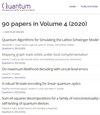超越平均情况的噪声量子电路泡利路径模拟
IF 5.1
2区 物理与天体物理
Q1 PHYSICS, MULTIDISCIPLINARY
引用次数: 0
摘要
对于深度为$n$量子比特$\Theta(\log n)$的随机量子电路,使用泡利路径方法[1]可以有效地完成从输出状态采样的任务。本文旨在研究该方法在随机电路之外的性能。我们首先考虑由Clifford门和T门组成的电路中局部可观测值的经典模拟$\unicode{x2013}$,超越平均情况分析,我们从噪声率和T门的门的分数方面得出了可模拟的充分条件,并表明如果以比T门更快的速度引入噪声,则模拟变得典型容易。作为这一结果的应用,我们研究了二维QAOA电路,试图在一般图上找到经典Ising模型的低能态。在那里,我们的结果表明,对于问题的硬实例,对应于几何非局部的Ising模型图,如果以恒定速率去极化,使用SWAP门映射到几何局部电路结构的QAOA算法与经典算法相比没有任何渐近优势。最后,我们举例说明泡利路径方法无法给出正确结果的实例,并开始研究模拟给定量子电路的噪声脆弱性和经典复杂性之间的权衡。本文章由计算机程序翻译,如有差异,请以英文原文为准。
Pauli path simulations of noisy quantum circuits beyond average case
For random quantum circuits on $n$ qubits of depth $\Theta(\log n)$ with depolarizing noise, the task of sampling from the output state can be efficiently performed classically using a Pauli path method [1] . This paper aims to study the performance of this method beyond random circuits. We first consider the classical simulation of local observables in circuits composed of Clifford and T gates $\unicode{x2013}$ going beyond the average case analysis, we derive sufficient conditions for simulatability in terms of the noise rate and the fraction of gates that are T gates, and show that if noise is introduced at a faster rate than T gates, the simulation becomes classically easy. As an application of this result, we study 2D QAOA circuits that attempt to find low-energy states of classical Ising models on general graphs. There, our results shows that for hard instances of the problem, which correspond to Ising model's graph being geometrically non-local, a QAOA algorithm mapped to a geometrically local circuit architecture using SWAP gates does not have any asymptotic advantage over classical algorithms if depolarized at a constant rate. Finally, we illustrate instances where the Pauli path method fails to give the correct result, and also initiate a study of the trade-off between fragility to noise and classical complexity of simulating a given quantum circuit.
求助全文
通过发布文献求助,成功后即可免费获取论文全文。
去求助
来源期刊

Quantum
Physics and Astronomy-Physics and Astronomy (miscellaneous)
CiteScore
9.20
自引率
10.90%
发文量
241
审稿时长
16 weeks
期刊介绍:
Quantum is an open-access peer-reviewed journal for quantum science and related fields. Quantum is non-profit and community-run: an effort by researchers and for researchers to make science more open and publishing more transparent and efficient.
 求助内容:
求助内容: 应助结果提醒方式:
应助结果提醒方式:


